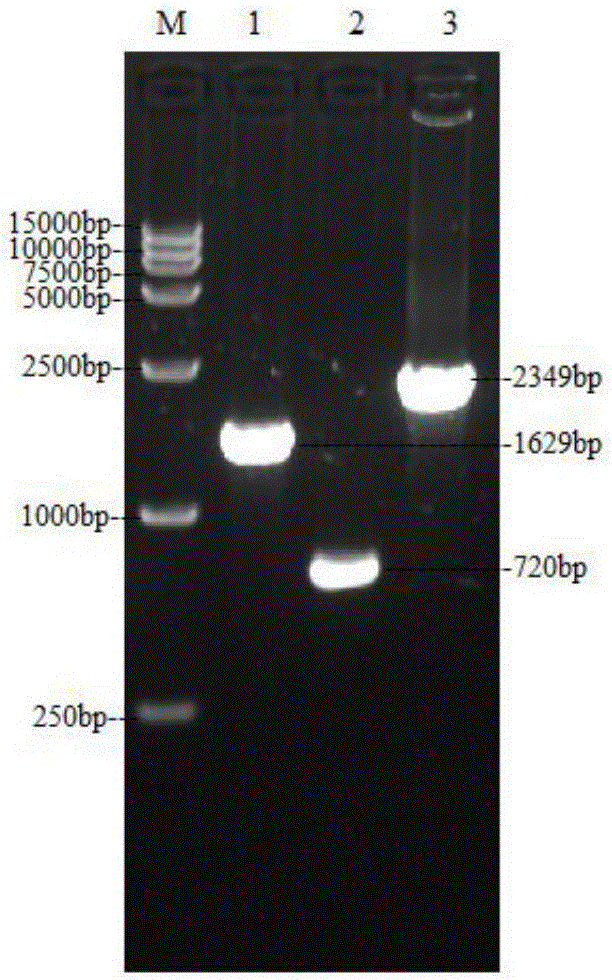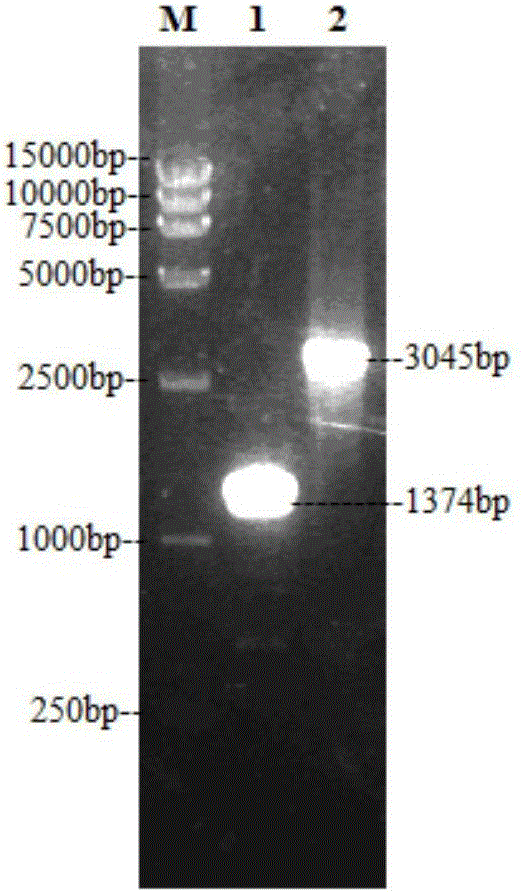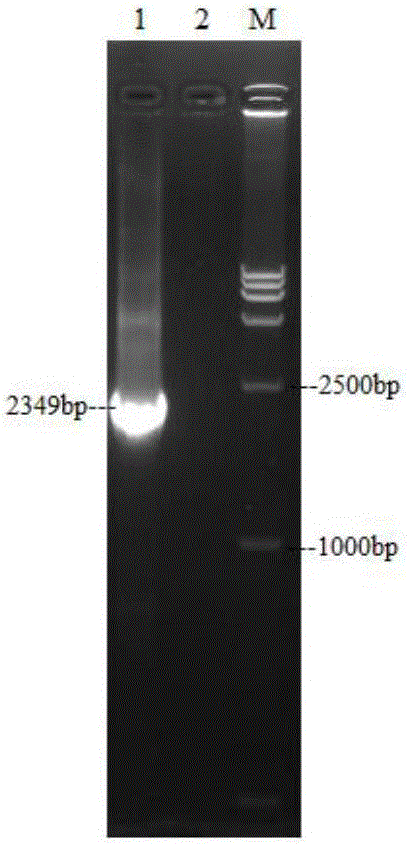NDV (Newcastle disease virus) recombinant virus expressing DHAV-1 and DHAV-3 VP1 genes and application thereof
A DHAV-1, DHAV-3 technology, applied in the field of molecular biology, can solve the problems of inability to protect DHAV-3 virus, immune prevention of unwell ducklings, and high production costs, and achieve healthy development, reduce immune stress, and reduce The effect of production costs
- Summary
- Abstract
- Description
- Claims
- Application Information
AI Technical Summary
Problems solved by technology
Method used
Image
Examples
Embodiment 1D
[0062] The connection of the VP1 gene of embodiment 1DHAV-1 type, DHAV-3 type
[0063] Referring to the nucleotide sequences of duck hepatitis virus DHAV-1VP1-2A gene and DHAV-3VP1 gene recorded in GenBank, DHAV-1 and DHAV-3 were used as materials respectively, and DHAV-1VP1-2A was amplified by conventional RT-PCR method gene and DHAV-3VP1 gene. According to the instructions, use Trizol reagent to extract DHAV-1 and DHAV-3 viral RNA, and use the following 1VP1-2A-F / 1VP1-2A-SOE-R, 3VP1-SOE-F / 3VP1-R primers to amplify respectively to obtain DHAV- 1VP1-2A and DHAV-3VP1 genes.
[0064] Described DHAV-1 carries out PCR amplification and is the primer P1 of DHAV-1VP1-2A gene as:
[0065] 1VP1-2A-F: 5'-TGGAATTCGGTGATTCTAACCAGTTG-3' (BamHI),
[0066] 1VP1-2A-SOE-R: 5'-CTGATTGGAATCACCTTGATCTGTAGTAAT-3';
[0067] The fragment size of the amplified product DHAV-1VP1-2A is 1652bp; the nucleotide sequence of the amplified product DHAV-1VP1-2A is shown in SEQ ID NO:1.
[0068] Describe...
Embodiment 2
[0078] Example 2 Construction of recombinant Newcastle disease virus expressing DHAV-1VP1-2A-3VP1
[0079] Using the recombinant plasmid pLS-RFP containing the full-length cDNA of LaSota (the RFP reporter gene is inserted between the P gene and the F gene) as a template, the self-designed primers LS-P-up and LS-F-down were used in the plasmid pLS-RFP The two ends of RFPORF were amplified by reverse PCR to obtain a linearized vector containing the full-length cDNA of LaSota:
[0080] LS-P-up: 5'-GGTGGCTACAACTATCAACTAAACT-3',
[0081] LS-F-down: 5'-GTGTGTAACTACCGTGTACTAAGC-3';
[0082] The fragment size of the amplified product is 18.524kb; the nucleotide sequence of the amplified product is shown in SEQ ID NO:4.
[0083] Using specific primers plant-VP1-F and plant-VP1-R to amplify the DHAV1VP1-2A-3VP1 gene, the end of the gene obtained contains the same 15bp extended sequence as the end of the LaSota linearized vector:
[0084] plant-VP1-F: 5'-atagttgtagccaccATGGGTGATTCTAAC...
Embodiment 3
[0091] Example 3 Rescue of recombinant virus rLS-1VP1-2A-3VP1
[0092] The recombinant vaccinia virus MVA / T7 (MOI=3) expressing T7 polymerase was inoculated in a 24-well plate with 90% monolayer HEp-2 cells, and after incubation for 1 h, 1.0 μg pLS-1VP1 HEp-2 cells were co-transfected with 2A-3VP1, 0.5μgpTM-NP, 0.25μgpTM-P and 0.05μgpTM-L helper plasmids. Six hours after transfection, the transfected cells were washed once with PBS, and DMEM medium containing 2% FBS and antibiotics was added. After 72 hours of transfection, the transfected cells were repeatedly frozen and thawed 3 times, the rescued recombinant virus was harvested, and it was inoculated into 9-day-old SPF chicken embryos, the allantoic fluid was harvested, and the allantoic fluid that was positive for hemagglutination (HA) was used A 0.22um filter was used to filter out the poxvirus, and it was continuously passaged on 9-day-old SPF chicken embryos. The harvested virus was stored at -80°C, and the recombinant...
PUM
 Login to View More
Login to View More Abstract
Description
Claims
Application Information
 Login to View More
Login to View More - R&D
- Intellectual Property
- Life Sciences
- Materials
- Tech Scout
- Unparalleled Data Quality
- Higher Quality Content
- 60% Fewer Hallucinations
Browse by: Latest US Patents, China's latest patents, Technical Efficacy Thesaurus, Application Domain, Technology Topic, Popular Technical Reports.
© 2025 PatSnap. All rights reserved.Legal|Privacy policy|Modern Slavery Act Transparency Statement|Sitemap|About US| Contact US: help@patsnap.com



